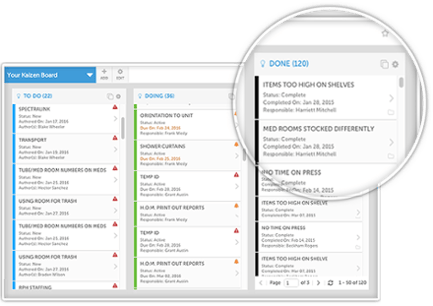 Every time we walk into a facility and see a Kaizen board, we are reminded about the excitement and sense of anticipation that most teams have when the Kaizen board is first introduced. But very often, when we ask front line employees about them the response is tepid at best.
Every time we walk into a facility and see a Kaizen board, we are reminded about the excitement and sense of anticipation that most teams have when the Kaizen board is first introduced. But very often, when we ask front line employees about them the response is tepid at best.
There may still be huddle meetings where the progress of each improvement is discussed, and a card might get moved from one stage to another from time to time, but the initial excitement wanes quickly and the whole thing becomes a chore.
In many cases, we look a little closer and see that no new improvement work has been added for months or that work is stalled out with no movement in sight.
Why is it that an improvement tool that is so popular so often flounders or outright dies? There are a few common reasons.
Listen to this post or subscribe to the podcast (post continues below):
Without an Improvement Culture, Kaizen Boards are Doomed from the Start
A Kaizen board is a tool for improvement. Much like a hammer is a tool for building a shelf. You can more easily build a shelf with a hammer than without one, but having a hammer does not a shelf guarantee. Unless someone is motivated and incented to build a shelf and the other necessary resources, like wood and nails are available, you aren’t getting a shelf. If employees do not see improvement work as a key aspect of their job and if management doesn’t recognize and reward employees who engage, a Kaizen board won’t get you very far at all.
Improvement Work Shouldn’t Be Confined to a Place or Time
Most Kaizen boards are hung on a wall in a certain location and given attention during daily or weekly improvement meetings, often called huddle meetings. Why is this a problem? It conditions people to think about improvement within a very specific context. But we don’t want people to think about and act on improvement initiatives only at 10:15 AM in the staff room. We want them looking for ways to affect positive change all day, every day, wherever they happen to be.
Kaizen Boards Offer Only a Snapshot
Even if you’ve instilled the perfect Kaizen culture and your team is raring to go on improvement work, a physical Kaizen board is still an imperfect tool because it provides only a snapshot of the current state of each project. It is not designed to track the results of completed improvement over time, to capture lessons learned during past projects, or to ensure that priorities are aligned with the organization’s strategic plan. All of that requires something that can’t be executed with poster board and post-it notes.
The Alternative
Every organization that has implemented a Kaizen board or considered doing so is starting from a good place. They want a way to structure improvement and get employees involved in making the company better on a daily basis. They are looking to keep improvement efforts top of mind and to provide a way to visually manage progress. Bravo!
But the way to get the most out of this positive energy is to instead use software that includes digital management that is far more useful and sophisticated than the traditional Kaizen board. With the right technology in place, each employee can engage in submitting opportunities for improvement, working on projects, or tracking the results of change from anywhere, at any time. Leaders get a snap shot of the health of the entire organization without wandering from board to board and the results of change can be measured against key objectives over the long run.
A digital Kaizen solution forms a repository of organizational knowledge and makes it possible for each improvement effort to build on the last. It keeps teams from repeating mistakes and makes everyone smarter each time a project is completed. It also makes it easy to recognize and reward people who contribute the best ideas and those who take the right steps to execute new innovations. Broadcasting this success feeds the improvement culture and sets the stage for bigger and better changes.
If your Kaizen board didn’t lead to the change you were looking for, don’t feel bad. You are certainly not alone. Kaizen software takes the underlying ideas and applies them in a much more effective way to ensure that your team gets the results they seek.



Add a Comment